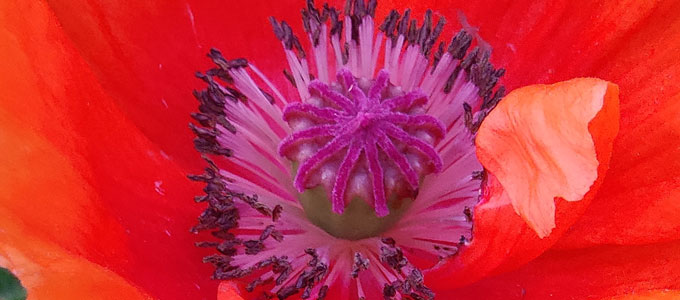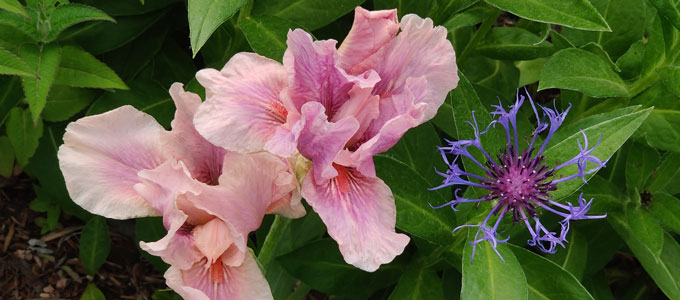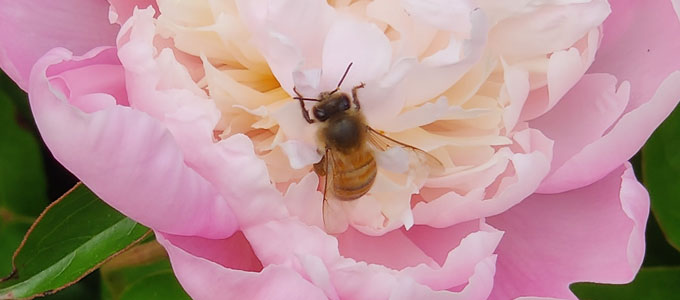|
A biweekly newsletter from the Anthroposophical Society in America
 |
|
June 6, 2021
Dear Members & Friends,
Seventy-five people have donated so far to our spring appeal, “Share the Love”. The Youth & Inclusion Access Fund provides financial aid for those who want to participate in ASA programs. It helps expand the reach of anthroposophy while supporting full enrollments—a win for everyone. Thank you!
Color, said Rudolf Steiner, is the soul of Nature and of the entire cosmos. It’s a lovely statement, and it deepens quickly when set beside Goethe’s statement that Colors are the deeds and suffering of light—sufferings?—and his view of color emerging from between darkness and light. It becomes something worth pondering.
Our photography, a word which means “drawing with light,” continues from Whitsun with images of flowers, at or near Rudolf Steiner House in Ann Arbor, with some vivid colors...
|
|
 |
|
SUMMER, READING
Anthroposophists will never lack good reading material, including wonderful stories for children. There are also some new myths and legends and novels suitable for adults. SteinerBooks recently emailed an “author spotlight” focused on Shirley Latessa’s five-volume series “Auragole’s Journey” and her two novels Eighteen Days Till Home and Dancing in the Fire, whose protagonists are drawn to the Mediterranean and perhaps in and out of time.
From A. Roz Mar is coming soon a fifth book of the Rosenhart Collection.
It’s the 14th Century and the secret school must quickly be dissolved. King Philip the Fair has imprisoned knights and the Templar Grandmaster Jacques de Molay and threatens all honourable men, so the Turtledove Knights are no more. The sorcerer of the dark arts Klyccansor was killed by Rosenhart's son Emrys in Book IV. The wicked sorceress Orchis now does his bidding between worlds. They plan punishment of Rosenhart through his children and suffering for mankind, and once again Klyccansor plots to steal the sword of the greatest of all warriors, the Arch Spirit Michaél. Can Rosenhart help his fellows and family from out of the land of spirit?
Email the author bluepearlarts@lycos.com to request Chapter 1 from the first Rosenhart book, The Sight, and learn more at her website.
Last August we mentioned Eric G. Müller’s The Black Madonna and the Young Sculptor: Mythic Dimensions of Celtic Chartres, and have had good reports of his other books. Those include The Invisible Boat and its sequel The Invisible Boat and the Molten Dragon, for which the teaser asks,
“Ever wonder about the living beings who drive the wild untamable fires in the west? Here is a tale that makes pictures for us all of the powerful beings driving such natural events forward! These are important pictures to draw us closer to nature in a different way from our ordinary thinking.”
There are other books at Eric’s author page, including non-fiction and poetry, topped by Tiny Tin Elf which features illustrations by Ella Manor Lapoint. Ella has been making a thing of beauty of the Berkshire-Taconic Branch newsletter Chanticleer, and a few years ago she did an amazing cover for being human’s issue for the centenary of eurythmy, which you are free to download.
|
|
 |
|
WALDORF, ALL TOGETHER
School Renewal and the Heart of Change is the first ever joint Waldorf education conference. It has been collaboratively planned by the three organizations WECAN (Waldorlf Early Childhood Association of North Ameria), AWSNA (Association of Waldorf Schools of North America), and the Alliance for Public Waldorf Education. The goal is to spark new ways of working in and across schools, and new ways of thinking about their place in the transformation that is happening in the world.
It is also the first truly accessible Waldorf summer conference. Virtual means ANYONE can attend at $50 to $200 per person. And all recorded content can be accessed (by those who are registered) for a one year period, including the four keynote sessions with live Q&A and 15 webinars on topics for early childhood, high school, parents, school leaders, and everyone in between.
“You don't need to be a delegate, you don't need to know the handshake. You do need to join us, in any way that works for you: full screen, audio only, while washing your painting jars, while sitting on your lawn. Please click here to take a look at all we have in store for you. Registration has been extended to June 17, so click here and register today. Warm regards, The Conference Committee: Beverly Amico, Liz Beaven, Jennifer Chace, Susan Howard, James Pewtherer, Melanie Reiser, and Stephanie Rynas.”
|
|
 |
|
#KidsOnTech
Henning Kullak-Ublick at Waldorf 100 has alerted us that “the film-maker who created our Waldorf-100 films has collaborated with us again to create an outstanding film on the contentious issue of children and technology. (And in case you want to revisit the 45-minute film of our festival, you can still find it on our website waldorf-100.org.)” At kidsontech.film the filmmakers write,
The issue here is to raise a child that is not vulnerable to being preoccupied, or addicted to the digital world. And it can be done! Our team came to this topic long before Covid and not as filmmakers, but as parents raising young children between the ages of one and nineteen. Moms and dads at our kids’ schools all ask the same questions: How much Youtube does your kid watch? Did you let your kid watch “His Dark Materials”? Does your kid have a smartphone?
And then Covid hit! Most of us were relieved to have zoom classrooms and that facsimile of education referred to as, “distance learning.” But children around the world are now emerging even more obsessed with their devices. The science is clear: Heavy use of tech can profoundly compromise healthy “brain development” in young children.
We made this film to remind parents of what we already know — instinctively, as parents — children need to experience outdoor play, work with their hands, engage with their friends, and figure out what to do when they become insufferably bored. In making this film, we wanted to explore how we might both protect and prepare our children for a rapidly changing world where turning back the clock is not an option. While editing the film, everyone wanted us to offer a simple answer; but there were none.
Our process was to seek out intimate conversations with parents, teachers, neuroscientists, tech executives, child psychologists, and kids of every age from around the world hoping to better understand what’s become humankind’s greatest social experiment. Is tech somehow inherently evil? Should we shield our children from it at all costs? Certainly not, nor could we if we tried. Our goal is not to tell you what to do. Rather, we hope this film can help start a conversation that is as important and alive today as climate change.
Click here for online resources...
|
|
 |
|
ECONOMY; HIBERNIA
The Economics Conference of the Goetheanum wrote about its various online resources, and announced an interesting new book. The Conference’s literature for professionals is available at the aeBookstore where the Associative Economics Worldwide imprint is especially concerned with the formal work being done in academia to explore Steiner’s key ideas including true price, personal (not real) credit, money is bookkeeping, three kinds of money. An example is Arthur Edward’s Three Kinds of Money - Rudolf Steiner and the Development of Monetary Economics, which places Steiner's three kinds of money in the context of many other threesomes that can be found through a survey of most of today's main schools of economic and monetary thought.
Another book that caught our eye: Step into Another World: Economic Life as a Medium for Modern Initiation. That’s a new thought... For teachers there are resources for associative financial literacy on a new website associative-financial-literacy.com. And the journal Associate! continues on a regular basis; please visit or email economics@goetheanum.org.
The new book, Guarding the Shores, stems from a 2018 conference on Inis Mor, off the West coast of Ireland, co-carried by the Anthroposophical Societies of Ireland, Romania, and Switzerland. It gathers materials contributed by Peter Selg, Marc Desaules, Vlad Popa, and Crispian Villeneuve and Alan Potter from Ireland, and is now available online at Lulu Bookstore. To quote a review by Sean Byrne, “The title of the book refers to how Ireland can be viewed, in accordance with certain indications given by Rudolf Steiner ... as guarding the shores of Europe against evil influences emanating from America... Hibernia has always been a rich source of inspiration, and this book proves that that inspiration has by no means dried up despite all the multiplying forces of opposition to the spirit that are manifesting in our time.” From the cover text: “‘Hibernia’ is not merely an Irish theme, nor only a European one. It is of universal meaning for a humanity that finds itself increasingly at the threshold, but without the ‘vocabulary’ for understanding this experience.”
|
|
 |
|
EDITH MARYON
Dottie Zold writes, Our community is lifting up the picture of the original Vorstand for healing and reconciliation in our imaginations out of Fred Janney’s inspiration a few years past (PDF here). We created two gatherings with Dr. Michaela Gloeckler for Ita Wegman and then Marie Steiner and now we are creating one for Edith Maryon on June 26, and then the other three Vorstand members, Guenther Wachsmuth, Elizabeth Vreede and Albert Steffen.
Edith Maryon - Rudolph Steiner and the Christ Sculpture, June 26th, 11:00 am PDT, 2:00 pm EDT. Join Circles for a Renewal of Culture for presentations on a remarkable individual Edith Maryon, to support the translation and publishing of the recent biography by Peter Selg. Patricia Dickson of the Visual Arts Section Council writes, “Edith Maryon (February 9, 1872 - May 2, 1924), accomplished English sculptress, is known by most anthroposphists as a helper to Rudolf Steiner in creating the sculpture group The Representative of Humanity, working side by side for a decade in artistic dialogue during the building of the first Goetheanum. As anthroposophists we owe her a huge debt of gratitude not only for her artistic legacy but also how she modeled for each one of us earnest spiritual striving, selfless devotion, and a sense for the practical.” Keynote by Peter Selg, introduction by Patricia Dickson, presentations by Brigitta Gallaher and Rembert Biemond of the Edith Maryon Foundation. To register for a Zoom link, email Dotty + Frank at CirclesForaRenewalofCulture@gmail.com
|
|
 |
|
Our last photo, above, was taken in one corner of Ann Arbor’s Arboretum, in a field of peonies, Whitsun roses. It is a paradisal vision for several weeks, this time of year, and it was good to catch sight of a bee at work in this blossom of rose and cream and white. But it was one of only three bees I spotted that day, among so many flowers. Goethe observed that Nature is only made complete in human appreciation. What a glorious duty that appreciation is, and how sad if we let ourselves be distracted from it.
Thank you for reading and viewing, and enjoy the beauty of flowers and colors wherever you find them!
John Beck
Editor, being human
editor@anthroposophy.org
Anthroposophical Society in America
|
|
|
|
|